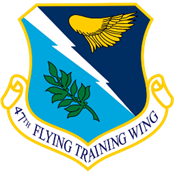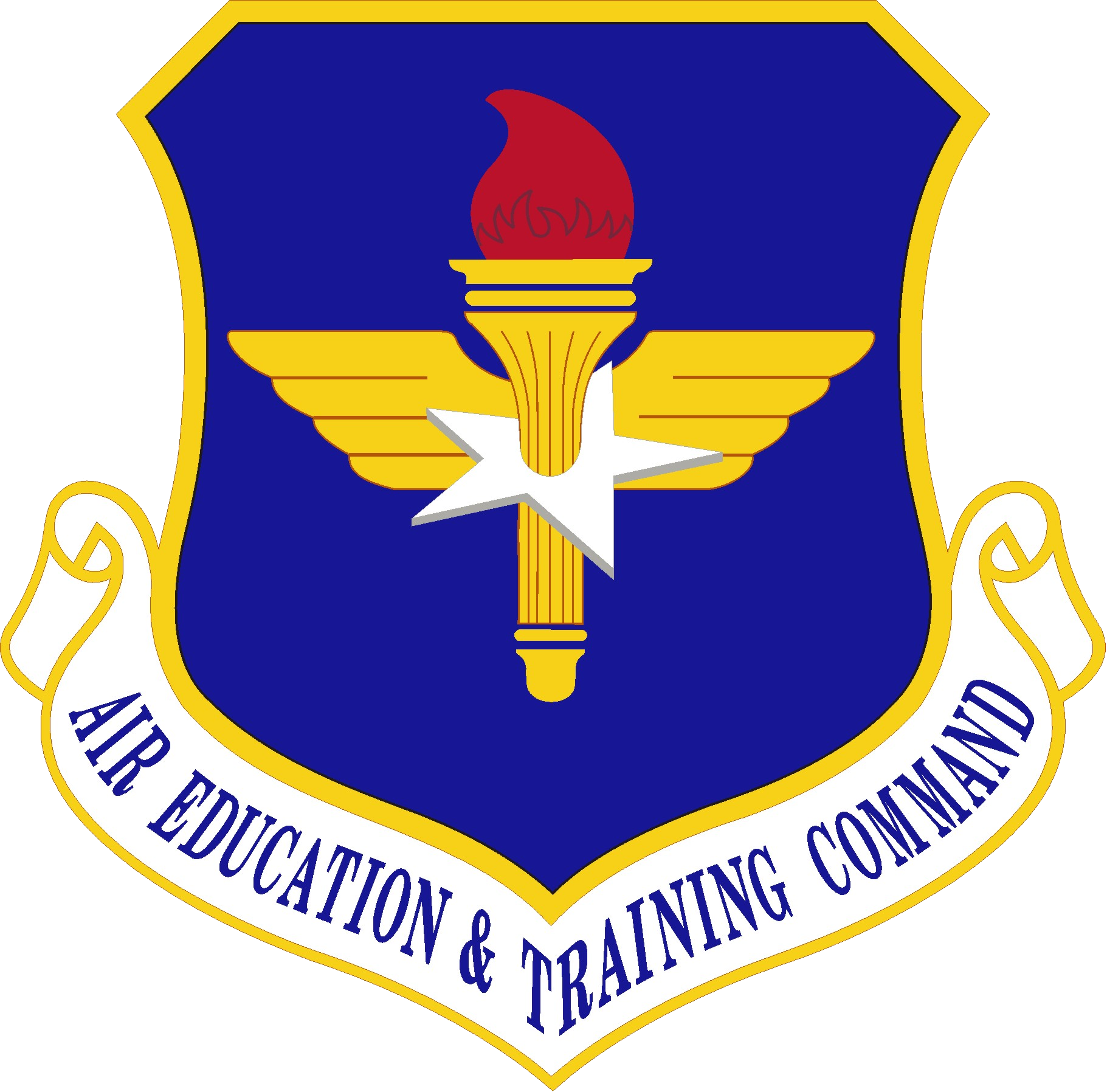
T‑7A Recapitalization
Environmental Impact Statement

Laughlin Air Force Base, Texas
About
Introduction
The Air Force has prepared an Environmental Impact Statement (EIS) to address its proposal to recapitalize the T‑38C Talon flight training program at Laughlin Air Force Base (AFB) with T‑7A Red Hawk aircraft. This proposal supports the Secretary of the Air Force’s strategic basing decisions to recapitalize existing T‑38C pilot training installations, and Laughlin AFB would be the third of five installations to be environmentally analyzed for possible recapitalization.
An EIS is the most detailed analysis prescribed by regulations implementing the National Environmental Policy Act (NEPA) and is a public document. Public involvement is a vital component of the NEPA process.
Background
The Air Force plans to recapitalize its T-38C fleet at Air Education Training Command's five pilot training installations: Joint Base San Antonio (JBSA)-Randolph in Texas, Columbus AFB in Mississippi, Laughlin AFB in Texas, Vance AFB in Oklahoma, and Sheppard AFB in Texas. JBSA‑Randolph was selected as the first installation to undergo recapitalization because it provides the majority of instructor pilot training and is an Introductions to Fighter Fundamentals location. Recapitalization of JBSA-Randolph would serve as an essential first step in establishing a T‑7A instructor pilot pipeline and would set the conditions to transition to T‑7A training at the other four pilot training installations.
On January 29, 2021, the Acting Secretary of the Air Force approved the preferred sequencing and locations for the next four installations to possibly undergo T‑7A recapitalization. Acting on Air Education Training Command's recommendations, the Acting Secretary selected Laughlin AFB to be the third installation to be analyzed environmentally for possible recapitalization. Recapitalizing Laughlin AFB third would result in the least impact on continued pilot production during the transition between aircraft types, provide the most efficient cost and student production and management plan, and align with Air Education Training Command's student pipeline flow for the Specialized Undergraduate Pilot Training and Introduction to Fighters Fundamentals curricula. Vance and Sheppard AFBs would follow as the fourth and fifth installations, respectively.
What Is Being Proposed?
Recapitalization entails:
- Replacement of all T-38C aircraft assigned to Laughlin AFB with T-7A aircraft.
- Transition of aircraft operations at Laughlin AFB and associated special use airspace from the T‑38C to the T-7A.
- Introduction of nighttime (between 10 p.m. and 7 a.m.) T-7A operations.
- Changes to the number of personnel and dependents in the Laughlin AFB region. Specifically, Laughlin AFB and surrounding region would experience a 190 staff and 361 dependent increase during the aircraft transition period of 2030 and 2031 and a 60 staff and 114 dependent decrease (relative to current personnel levels) after 2031.
- Construction of and upgrade to pilot training, aircraft operations, and maintenance facilities. Specifically, six military construction and seven facility sustainment, restoration, and modernization projects would be undertaken. These projects include construction at Laughlin AFB of a new Ground Based Training System Facility, Unit Maintenance Trainer Facility, and hush house; addition to the Egress Shop; and either 48 or 60 T-7A shelters.
The number of T‑7A aircraft, aircraft operations, and nighttime operations is evaluated as part of the Proposed Action. The Air Force is considering three reasonable action alternatives (i.e., Alternatives 1, 2, and 3) and no action.
Alternative 1: 63 T‑7A Aircraft and Operations at a Level Sustaining Pilot Training while Simultaneously Phasing Out the T‑38C and Phasing In the T‑7A. Laughlin AFB would receive 63 T-7A aircraft between 2030 and 2033. Pilot training operations would gradually transition from the T-38C to the T-7A during 2030, and pilot training operations would be performed at a level to meet the Air Force's anticipated training needs. Operations are takeoffs, landings, the approach phase of a “touch-and-go”, and the takeoff phase of a “touch-and-go”. Up to 493 annual nighttime T-7A operations would occur. Existing military training airspace would be used, and no changes to airspace configurations would be required. All T-7A operations would be sub-sonic.
Alternative 2: 63 T‑7A Aircraft and Operations 25 Percent Greater than Alternative 1. Alternative 2 would be identical to Alternative 1 except T-7A operations would be 25 percent greater than Alternative 1. Up to 613 annual nighttime T-7A operations would occur. Alternative 2 covers a scenario in which the Air Force requires a potential surge in requirements.
Alternative 3: 79 T‑7A Aircraft and Operations 25 Percent Greater than Alternative 1. Alternative 3 would be similar to Alternatives 1 and 2 except 16 additional T-7A aircraft would be delivered in 2030 and 12 additional T-7A shelters would be constructed. T-7A operations would be identical to Alternative 2. Alternative 3 is intended to provide the Air Force with operational flexibility so that 16 additional T-7A aircraft can be assigned to Laughlin AFB, if needed.
No Action Alternative: Does Not Implement T‑7A Recapitalization at Laughlin AFB. The No Action Alternative assesses the environmental consequences from taking no action and serves as a baseline to compare the environmental consequences of the Proposed Action. For the No Action Alternative, the Air Force would not implement T-7A recapitalization at Laughlin AFB. The existing fleet of T-38C aircraft would continue to be used in their current capacity even though they will reach the end of their service lives within the next decade and maintenance requirements would continue to increase. No changes to current flight operations would occur. No changes to the number of personnel and dependents would occur, and no construction would be undertaken.
FAQs
The National Environmental Policy Act (NEPA) of 1969 was enacted to address concerns about environmental quality. NEPA's main objectives are as follows:
- Ensure that federal agencies evaluate the potential environmental impacts of proposed programs, projects, and actions before decisions are made to implement them
- Inform the public of proposed federal activities that have the potential to affect the human environment, including the natural and physical environments
- Encourage and facilitate public involvement in the decision-making process
NEPA requires a federal agency to analyze impacts from a proposal and its alternatives, and provides the public with opportunities to participate in the process.
An Environmental Impact Statement or EIS is a detailed public document describing a proposed action, all alternative actions that were considered, and the environmental impacts of implementing the proposed action and reasonable alternatives.
Regulations specify that an EIS be prepared when a federal agency proposes a major action with the potential to significantly affect the quality of the human environment. An EIS is required to “provide a basis of consideration and inform decisionmakers and the public of the reasonable alternatives.”
The T‑38C is a twin-engine, high-altitude, supersonic jet used by the Air Force and other nations for pilot training. The T‑38C trains airmen for various fighter and bomber aircraft, including the A‑10 Thunderbolt, B-1B Lancer, F-15C Eagle, F-15E Strike Eagle, F-16 Fighting Falcon, F‑22 Raptor, and F-35 Lightning II. The Air Force's Air Education and Training Command operates the T‑38C from five pilot training installations: Joint Base San Antonio (JBSA)-Randolph in Texas, Columbus AFB in Mississippi, Laughlin AFB in Texas, Vance AFB in Oklahoma, and Sheppard AFB in Texas.
The T-7A is a new type of aircraft that the Air Force will use for pilot training. The T-7A will enable pilots to train more efficiently with modern avionics better preparing them to fly 4th and 5th generation aircraft.
The T‑38C originally was developed in the 1950s with production occurring between 1961 and 1972. The fleet has undergone periodic upgrades over time, including in 2001 when modern avionics and upgraded propulsion components were installed to provide increased performance and superior reliability. Nevertheless, as an older aircraft, training with the T‑38C does not adequately prepare pilots for the technological advancements of modern fourth and fifth generation [1] aircraft, including nighttime flight training. Furthermore, T‑38C aircraft incur greater maintenance requirements as they age. Greater maintenance issues lead to more downtime of individual aircraft, which threatens the availability of pilot training hours. The T‑38C is expected to reach the end of its service life within the next decade. To provide a training environment suitable for modern aircraft, the Air Force plans to recapitalize the T-38C fleet with T-7A aircraft. The T‑7A recapitalization program will allow the Air Force to provide more efficient and effective pilot training for operating fifth generation aircraft.
[1] “Fourth generation aircraft” refers to those aircraft developed or manufactured with updated variants in the later part of the 20th century such as the F-15E or the F-16. “Fifth generation aircraft” refers to modern aircraft with advanced avionics developed in the early part of the 21st century such as the F-22 and F-35.
The Secretary of the Air Force has made strategic basing decisions to recapitalize existing T-38C pilot training installations. Laughlin AFB would be the third of five T-38C installations to be environmentally analyzed for possible recapitalization. Recapitalizing Laughlin AFB third would result in the least impact on continued pilot production during the transition of aircraft types, provide the most efficient cost and student production and management plan, and align with Air Education and Training Command's student pipeline flow for the Specialized Undergraduate Pilot Training and Introduction to Fighters Fundamentals curricula.
The Air Force published the Notice of Intent for the EIS in the Federal Register on January 17, 2023. The Air Force incorporated public input obtained during scoping into their proposal and performed the environmental impact analysis.
The Notice of Availability for the Draft EIS was published in the Federal Register on November 9, 2023. The Air Force accepted public comments on the Draft EIS until January 8, 2024.
After that time, the Air Force considered the public's input on the Draft EIS and published the Final EIS on June 21, 2024. The 30-day Final EIS post-filing waiting period ended on July 22, 2024.
After the 30-day waiting period ended, the Air Force signed a Record of Decision selecting Alternative 3 for implementation at Laughlin AFB.
The Department of Defense has developed a guide on military noise management for communities. You may view the guide at this link.